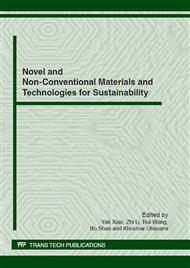p.622
p.628
p.635
p.646
p.653
p.661
p.669
p.677
p.683
Sanitary Ware Industry as an Aggregate to Produce Concrete and Mortar
Abstract:
Chemical analysis of household waste from the sanitary ware industry is of fundamental importance in order to detect the presence of AAR (alkali-aggregate reaction), the same in field or laboratory. There are several test methods, these methods can detect pre-reactivity of aggregates compared to the sodium or potassium hydroxide present in hydrated cement paste. For the preparation of both the concrete and the mortar, from the recycled material, the aggregates were reduced until it had texture, close to the river sand and gravel. The analyses stayed in determining the potential of the alkali-aggregate reactivity. Thus the results of chemical and physical characterization of the material, indicated a willingness to be used as aggregate in mortar and concrete, due to the availability of waste, the good properties given and the gains in cost, beyond the environmental management, they promote the viability of the process of recycling of waste. 1
Info:
Periodical:
Pages:
653-658
Citation:
Online since:
June 2012
Keywords:
Price:
Сopyright:
© 2012 Trans Tech Publications Ltd. All Rights Reserved
Share:
Citation:


